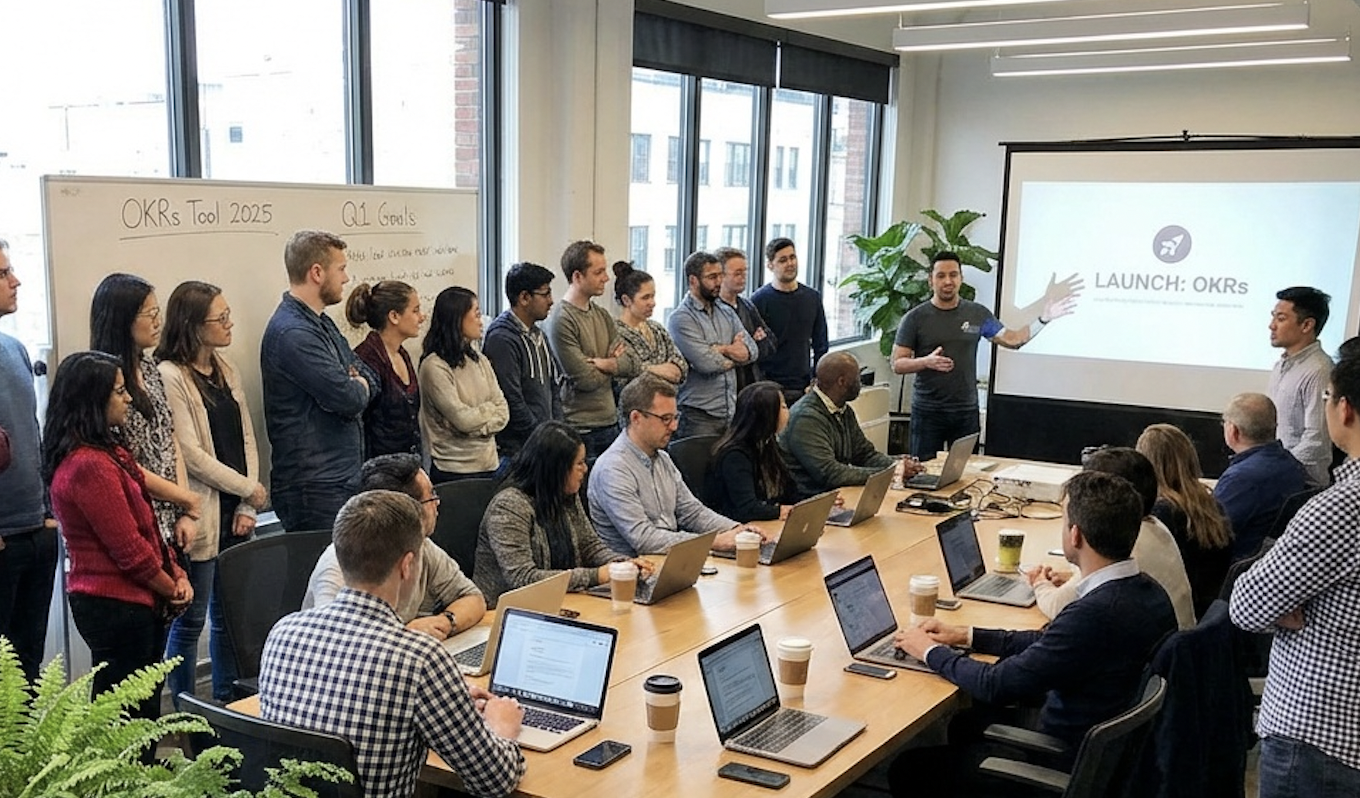The graveyard of startups is full of smart, hard-working teams.
They didn’t run out of ideas. They didn’t run out of hustle.
One team chased growth. Another fought churn. A third rebuilt the product from scratch.
All important work - but all pulling in different directions.
Company-level OKRs change that.
They take your vision and strategy and wire them directly into the daily work of every team.
With those principles in mind, let’s explore what great OKRs look like across different business priorities.
🧭 Strategic Growth
When your priority is to dominate your market and scale sustainably, your OKRs should create a rallying point for every department.
Objective: Position the company as the market leader in our category by year-end.
KR1: Increase share of voice in industry media from 12% → 25%.
KR2: Win 3 “Best in Industry” awards from top-tier publications.
KR3: Secure 10 new enterprise partnerships worth $2M+ in combined ARR.
Objective: Build a sustainable, scalable growth engine.
KR1: Grow ARR from $8M → $12M while keeping CAC payback under 9 months.
KR2: Increase inbound lead volume by 40% without increasing ad spend.
KR3: Reduce churn rate from 9% → 5%.
Objective: Expand brand presence through strategic thought leadership.
KR1: Publish 12 guest articles in top-tier industry publications.
KR2: Secure speaking slots at 5 major industry conferences.
KR3: Grow LinkedIn company followers from 20K → 40K.
Objective: Strengthen competitive moat through proprietary data and insights.
KR1: Launch a quarterly “State of the Industry” report with 5K+ downloads.
KR2: Develop 3 exclusive benchmark datasets for customers.
KR3: Achieve 80% positive media sentiment on brand coverage.
💰 Revenue & Profitability
Once growth is underway, profitability often becomes the next big lever. Here, your OKRs focus on making each dollar work harder.
Objective: Achieve record profitability without sacrificing growth.
KR1: Increase gross margin from 68% → 75%.
KR2: Cut non-essential operational expenses by 15%.
KR3: Expand upsell revenue to represent 20% of total ARR.
Objective: Diversify revenue streams.
KR1: Launch 2 new product lines contributing at least $500K ARR each.
KR2: Increase revenue from international markets from 8% → 20% of total.
KR3: Secure 15% of revenue from recurring subscription services.
Objective: Optimize pricing for profitability.
KR1: Test 3 new pricing tiers and measure impact on conversion and LTV.
KR2: Increase ARPU (average revenue per user) by 12%.
KR3: Reduce discounting in enterprise deals by 20%.
Objective: Improve cash flow management.
KR1: Reduce accounts receivable aging from 45 days → 25 days.
KR2: Negotiate vendor terms to extend payment cycles by 15 days.
KR3: Increase annual pre-paid contracts from 30% → 50% of total.
📈 Market Expansion
When your strategy calls for conquering new territories or customer segments, your OKRs should balance speed with adaptation.
Objective: Successfully enter and establish presence in the APAC region.
KR1: Sign 50 new APAC customers in 6 months.
KR2: Hire and onboard 5 local sales & support reps.
KR3: Adapt product for 3 key local compliance requirements.
Objective: Expand into mid-market while maintaining enterprise momentum.
KR1: Acquire 200 new mid-market accounts (>50 seats each).
KR2: Launch a mid-market pricing tier generating $1M ARR in 9 months.
KR3: Reduce enterprise sales cycle from 120 days → 90 days.
Objective: Enter two new vertical markets.
KR1: Secure 20 clients in healthcare and 20 in finance sectors.
KR2: Develop 2 industry-specific product features.
KR3: Publish tailored case studies for both verticals.
Objective: Increase partner-led expansion.
KR1: Sign 10 new reseller or referral partners.
KR2: Drive $1M in ARR through partner channels.
KR3: Deliver joint marketing campaigns with 5 top partners.
🤝 Customer Success & Retention
Winning customers is only half the battle. Keeping them and turning them into advocates is where long-term growth comes from.
Objective: Deliver an industry-leading customer experience.
KR1: Increase NPS from 42 → 60.
KR2: Improve first-response time in support from 4h → 1h.
KR3: Achieve 95%+ renewal rate across all customer segments.
Objective: Turn customers into advocates.
KR1: Launch a customer advocacy program with 50 active champions.
KR2: Generate 30 new case studies or testimonials.
KR3: Increase customer referral revenue from 2% → 10% of total.
Objective: Reduce churn in high-value accounts.
KR1: Identify top 20% of accounts at risk and create retention plans.
KR2: Conduct quarterly business reviews with all enterprise clients.
KR3: Reduce churn in top accounts from 8% → 3%.
Objective: Expand customer education initiatives.
KR1: Launch an on-demand training portal with 20+ modules.
KR2: Achieve 60% adoption of training among new customers.
KR3: Reduce support tickets per customer by 15%.
🚀 Product & Innovation
If product is your competitive advantage, OKRs here should push your team to innovate faster — without sacrificing quality.
Objective: Deliver our most impactful product release to date.
KR1: Launch new AI-powered analytics suite by Q3.
KR2: Achieve 50% adoption within existing customers in 60 days.
KR3: Reduce customer-reported bugs by 40% post-launch.
Objective: Accelerate innovation cycles.
KR1: Reduce average feature delivery time from 12 weeks → 8 weeks.
KR2: Run 5 customer co-creation workshops this quarter.
KR3: Prototype and validate 6 new product concepts.
Objective: Improve product onboarding experience.
KR1: Increase new user activation rate from 65% → 85%.
KR2: Reduce time-to-first-value from 5 days → 2 days.
KR3: Achieve 90%+ satisfaction scores on onboarding surveys.
Objective: Strengthen product reliability.
KR1: Achieve 99.99% uptime over the quarter.
KR2: Reduce average bug resolution time from 72h → 24h.
KR3: Implement automated regression testing covering 90% of codebase.
🧠 People & Culture
As you scale, your culture and leadership bench can either be your superpower — or your bottleneck.
Objective: Become a top-tier place to work in our industry.
KR1: Achieve an eNPS score of 70+.
KR2: Increase internal promotion rate from 18% → 30%.
KR3: Reduce voluntary attrition from 12% → 6%.
Objective: Build leadership capacity for scale.
KR1: Train 100% of managers in advanced leadership skills.
KR2: Launch a cross-functional mentorship program with 30 active pairs.
KR3: Fill 80% of leadership roles internally.
Objective: Foster a culture of continuous learning.
KR1: Offer each employee at least 2 professional development opportunities per quarter.
KR2: Achieve 75% participation in learning programs.
KR3: Launch an internal knowledge-sharing platform with 50+ contributions.
Objective: Improve diversity and inclusion metrics.
KR1: Increase underrepresented groups in leadership from 20% → 35%.
KR2: Conduct 2 company-wide D&I training sessions.
KR3: Achieve 90%+ favorable responses on inclusion survey questions.
🌱 Sustainability & Impact
For companies where impact is part of the mission, these OKRs help embed it into the business strategy.
Objective: Make sustainability a competitive advantage.
KR1: Reduce company carbon footprint by 25% year-over-year.
KR2: Shift 50% of suppliers to certified sustainable partners.
KR3: Launch 3 customer-facing sustainability initiatives.
Objective: Increase positive social impact in our communities.
KR1: Commit 1,000 volunteer hours across the company.
KR2: Allocate 2% of profits to community projects.
KR3: Partner with 5 non-profits on aligned initiatives.
Objective: Improve sustainability transparency.
KR1: Publish an annual sustainability report with third-party verification.
KR2: Achieve 90%+ compliance with ESG reporting standards.
KR3: Make sustainability metrics visible on company website.
Objective: Integrate impact goals into core business metrics.
KR1: Tie 20% of executive bonuses to sustainability outcomes.
KR2: Ensure 50% of new product launches include a measurable social or environmental benefit.
KR3: Partner with 3 suppliers to co-develop low-impact manufacturing processes.
We’ve covered a wide range of priorities — but remember, your company doesn’t need all of them at once.
Before you lock in your company-level OKRs, run them through this quick filter to make sure they’ll actually drive alignment and results:
Company OKRs are the connective tissue between your vision and execution.
When they’re clear, measurable, and inspiring, they give every team clarity on what matters most - and the confidence to say “no” to what doesn’t.
The best part? You don’t need dozens of them.






